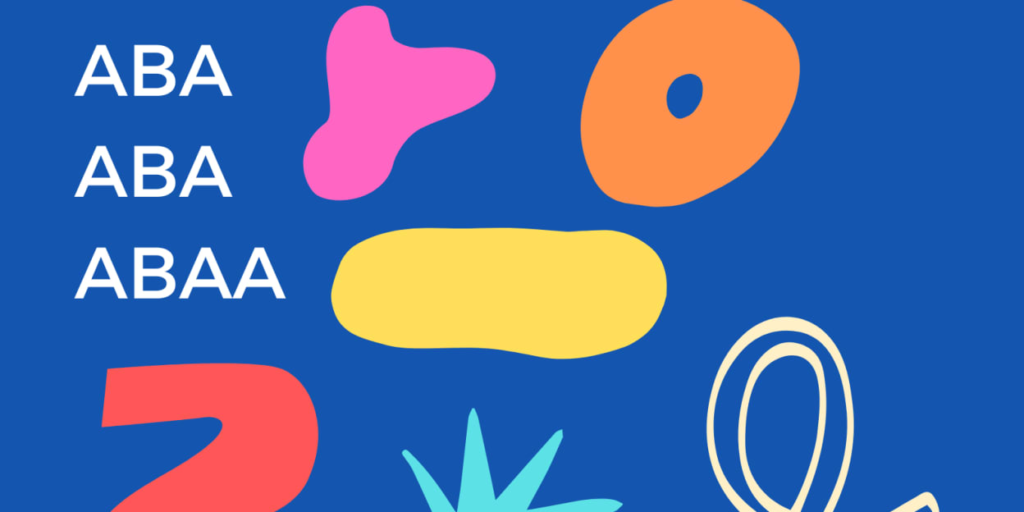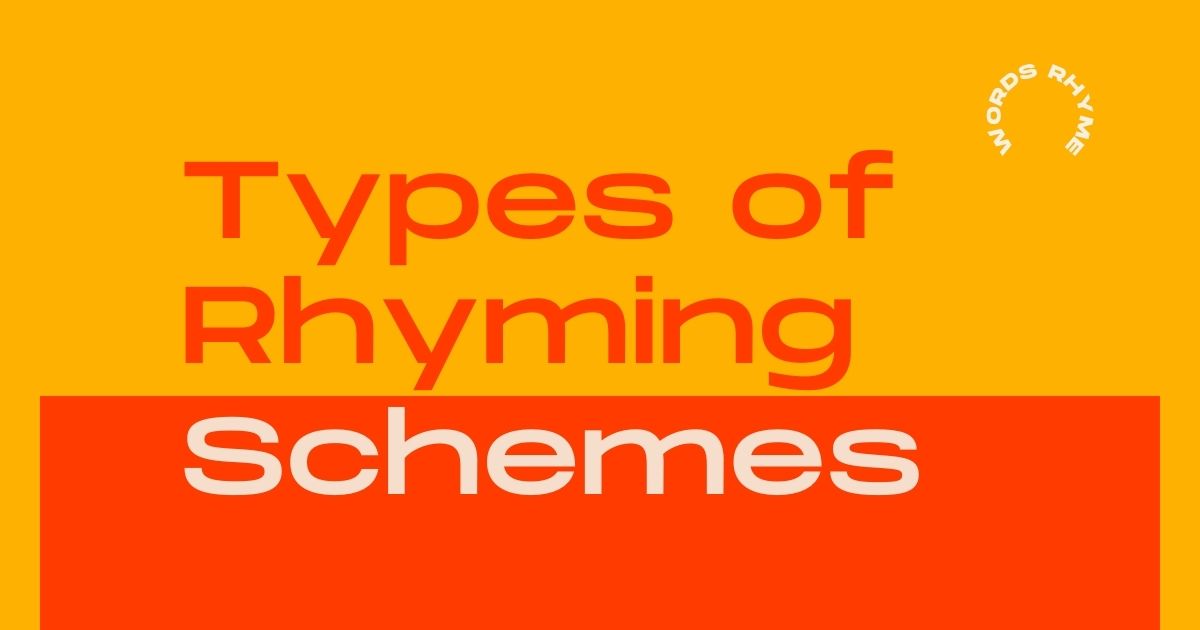Just like math which has many equations, poets also use many types of rhyming schemes in their works.
Whether you’re a full-fledged rhyme master or just a rhyme novice, expanding your knowledge of types of rhymes will take your wordplay to the next level.
We’ll look at classic rhyme structures like ABAB and explore off-beat options like rhyme royal. Dive in quickly to learn a couple of new things!
Table of Contents
What is a Rhyme Scheme in Poetry?
A rhyme scheme is the pattern of rhyming lines in a poem. It shows the repeating patterns of sounding sentences as we bounce from stanza to stanza. Schemes can flow consistently or change course, keeping readers on their lyrical toes.
Rhyming lines are denoted by letters, most commonly A, B, C etc. For example, a poem with lines that rhyme in an A, A, B, B pattern has an ABAB rhyme scheme.
Bid me to weep, and I will weep
To Anthea, who may Command him Anything – Robert Herrick
While I have eyes to see
And having none, yet I will keep
A heart to weep for thee
The most basic rhyme scheme is alternate rhyming, like ABAB CDCD. This is common in ballads, hymns and classic rhyming children’s poems.
Understanding the rhyme scheme helps analyze the poem’s rhythm, structure and message the poet aims to convey. The more a poet is skilled at rhyming, the more types of rhyming schemes they will use in their works.
Types of Rhyming Schemes
There are countless ways to arrange rhyming words within a poem, each creating a unique sound and emphasizing different aspects of your writing. Let’s explore the most common types from easy to advanced.
Simple Rhyming Schemes
1. Couplet Scheme
In a couplet scheme, the lines are broken into sets of two rhyming lines called rhyming couplets. Couplets create a singsong, back-and-forth rhythm that is easy for the ear to follow. They provide a steady, march-like pace.
Each rhyming couplet is represented by the same letter. For example, AABB indicates the first and second lines rhyme together (AA) and the third and fourth lines rhyme together (BB).
Twinkle, twinkle, little star,
How I wonder what you are. (AA)
Up above the world so high,
Like a diamond in the sky. (BB)
Twinkle, Twinkle Little Star – Jane Taylor
It is one of the simplest rhyme schemes as it only has two end rhymes that repeat in alternation, that’s why it’s commonly used in ballads, songs, hymns and other forms of folk poetry meant for oral transmission.
It is also quite frequently seen in children’s rhymes, Dr. Seuss books, greeting/occasion cards due to its rhythmic simplicity.
While straightforward, the couplet form still allows for creative expression within the short, rhyming pairs of lines.

2. Alternating Rhyme (ABAB)
In this pattern, the rhymes alternate between two end rhymes throughout the stanzas. The rhyming lines are represented as ABAB, where the first and third lines rhyme with each other (A) and the second and fourth lines rhyme together (B).
It follows a consistent rhyming pattern that is predictable yet not as singsong as a couplet. The alternating end sounds engage the reader’s ear without being too simplistic.
ABAB rhyme is very common in ballads, songs, and poetry meant to be sung since it maintains an easy rhythmic flow.
It works well for narrative poems telling a story over several stanzas through rhyme.
The people along the sand
Neither Out Far Nor in Deep – Robert Frost
All turn and look one way.
They turn their back on the land.
They look at the sea all day.
3. Enclosed Rhyme (ABBA)
The enclosed rhyme or enclosing rhyme scheme has a pair of rhyming lines framed around an internal half-rhyme. It is denoted as ABBA, with the first and last lines rhyming (A) and the internal lines forming a half rhyme or slant rhyme (B). The internal B lines add variety within the bracketed rhyming structure of ABBA.
This gives the poem a sense of rhyming couplets framed within a larger structure, creating interesting rhythmic tension between the full-end rhymes and internal half-rhyme.
The ABBA structure works well for short lyrical poems or songs telling a story over stanzas.
Visually, it “encloses” the half rhyme within the bookending full rhymes.
Beloved, my Beloved, when I think
Sonnet 29 – Elizabeth Barret Browning
That thou was in the world a year ago,
What time I sat alone here in the snow
And saw no footprint, heard the silence sink.
More Complex Rhyming Schemes
4. Triplet Rhyme (AAA)
If three lines rhyme, that’s a triplet. It is denoted simply as AAA and is a form of tercet, with all three lines sharing the same end rhyme.
The AAA triplet creates a sing-song quality with emphasis on the repeating rhyme sound. It can be used within a larger rhyme structure, like AAAA BBB for each stanza.

The repetitive triple rhyme adds musicality and draws out the rhyme sound for the reader, but it can be challenging to vary the structure and word choices across three lines.
In a solitude of the sea
Deep from human vanity,
And the Pride of Life that planned her, stilly couches she.
The Convergence of the Twain – Thomas Hardy
5. Monorhyme
In a monorhyme, all lines in a poem rhyme with one consistent end sound throughout. It is represented by a single letter like AAAA BBBB CCCC, AAA AAA AAA, etc.
This creates a very strong internal rhyming pattern with one dominating rhyme sound. Some poets use monorhyme to emulate spoken word lyrical styles and spiritual texts.
For beginners, it can be challenging to keep the language fresh and avoid monotony over many lines.
Variations include using slant or internal rhymes to offset repetition.
6. Tercet (ABA)
A tercet is a stanza or group of three lines. In an ABA scheme, the first and third lines rhyme with each other (A) and the second line is unique (B). The ABA pattern varies slightly from the sing-song quality of full rhyming triplets like AAA.
It creates a sense of envelope rhyme by rhyming the outer lines and leaving the internal line singular. The varied second line creates asymmetry and interest within the bracketing rhyme.

They work well for compact lyrical expressions where brevity is valued over narrative. Examples include Haiku, some forms of villanelle, and other compressed poetic styles.
What is the difference between tercet and triplet?
A triplet is a specific type of tercet where all three lines rhyme exactly, following an AAA rhyme scheme. A tercet is a three-line stanza in poetry. It doesn’t have any specific requirements for a rhyme scheme, making it quite versatile.
What is the difference between haiku and tercet?
A haiku has a specific syllable count of 5-7-5 syllables per line. A tercet doesn’t have any specific syllable count requirements.
7. Limerick (AABBA)
A limerick is a short, humorous, and often off-color five-line poem with a strict AABBA rhyme structure. The scheme rhymes the 1st, 2nd, and 5th lines together while the 3rd and 4th lines pair off with their own rhyme.
The rhythm is anapestic – two unstressed syllables followed by one stressed. The enclosed rhyme pairs at the end give it a feeling of completion within the tight structure.
Typical topics include alcohol, greed, boastfulness, and bodily functions. Bawdy themes are common.
Examples range from classics by Edward Lear to modern variants on Twitter.
Reading limericks aloud plays up their punchy, cheeky style aimed at oral tradition. Humor, brevity, and perfect phonetic precision define the form above all.
There was an Old Man who said, ‘Hush!
I perceive a young bird in this bush!’
When they said, ‘Is it small?’
He replied, ‘Not at all!
It is four times as big as the bush!’
Limerick No. 80, from A Book of Nonsense – Edward Lear
Figurative Rhyming Schemes
8. Internal Rhyme
Internal rhyme occurs when words inside the lines rhyme rather than just at the ends of lines.
It adds lyrical texture by echoing sounds inside individual lines or stanzas.
Common techniques include consonance (similar consonant sounds) and assonance (similar vowel sounds).
Too many internal words rhymes can seem forced, so they work best sprinkled judiciously.

Once upon a midnight dreary, while I pondered, weak and weary,
The Raven – Edgar Allan Poe
Over many a quaint and curious volume of forgotten lore—
While I nodded, nearly napping, suddenly there came a tapping,
As of some one gently rapping, rapping at my chamber door.
“’Tis some visitor,” I muttered, “tapping at my chamber door—
Only this and nothing more.”
9. Slant Rhyme
Slant rhyme is an imperfect rhyme where sounds are similar but not identical at the ends of lines. It includes vowel rhymes (e.g. rain/cane) or consonant rhymes (e.g. lost/most).
Slant rhymes create a less rigid, looser melodic effect than perfect rhymes. They add variety that can be used alone or alongside full rhymes in a scheme.
Popularized by Romantic poets seeking non-traditional forms, it draws attention if overused but adds musicality when judiciously placed.
Why should I let the toad work
Toads – Philip Larkin
Squat on my life?
Can’t I use my wit as a pitchfork
and drive the brute off?
Final Words
As you can see, there are many inventive ways for poets to play with rhyme and rhythm through different rhyming patterns. From simple couplets to complex internal rhymes, the right scheme can take a good poem and transform it into a smoothly flowing-work of lyrical beauty.
It’s impossible to give a definitive answer to how many rhyming schemes are there because the possibilities are infinite, so let your creativity guide you along with our blog as your trusted sidekick!


